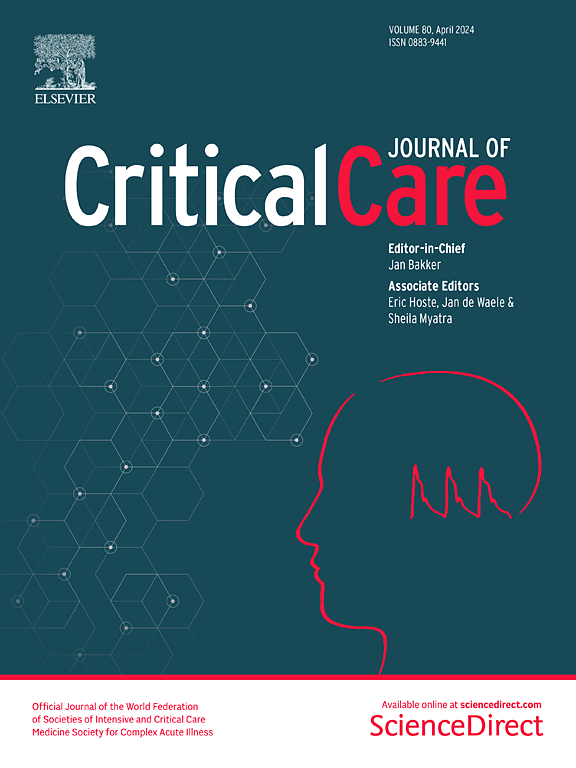低剂量吸入一氧化氮治疗对自主呼吸和插管的 COVID-19 患者的影响:一项回顾性倾向匹配研究
IF 8.8
1区 医学
Q1 CRITICAL CARE MEDICINE
引用次数: 0
摘要
吸入一氧化氮(iNO)疗法对 COVID-19 相关 ARDS 患者的益处尚不明确。我们开展了一项多中心回顾性研究,以评估 iNO 对需要呼吸支持的 COVID-19 患者的影响。这项多中心回顾性研究纳入了 SCCM VIRUS COVID-19 登记处登记的 COVID-19 患者,这些患者在 2020 年 3 月至 2022 年 6 月期间入住梅奥诊所的不同地点,需要高流量鼻插管 (HFNC)、无创通气 (NIV) 或有创机械通气 (IMV)。如果患者在插管前未插管或开始使用高流量鼻插管(± NIV),则被纳入 "自主呼吸 "组。插管前未使用 HFNC(± NIV)的患者被纳入 "插管组"。根据 iNO 的使用情况将他们进一步分为不同的组别。我们采用倾向得分匹配法(PSM)和反倾向治疗加权法(IPTW)来检验结果。在纳入分析的 2767 名患者中,1879 人属于自主呼吸组(153 人接受了 iNO 治疗),888 人属于插管组(193 人接受了 iNO 治疗)。在使用 iNO 后的 48 小时内,自主呼吸组和插管组的 FiO2 需求量、P/F 比值和呼吸频率均有持续改善。然而,在自主呼吸患者中,使用 iNO 后的插管风险没有明显差异(PSM OR 1.08,CI 0.71-1.65;IPTW OR 1.10,CI 0.90-1.33)。在使用 Cox 比例危险模型进行的时间到事件分析中,开始使用 iNO 的自主呼吸患者的院内死亡率危险比更低(PSM HR 0.49,CI 0.32-0.75;IPTW HR 0.40,95% CI 0.26-0.62),但插管患者的院内死亡率危险比更低。使用 iNO 与较长的院内停留时间、ICU 停留时间、通气持续时间和较高的肌酐升高发生率相关。这项回顾性倾向分数匹配研究显示,在时间到事件分析中,使用高频NC/NIV支持的自主呼吸COVID-19患者使用iNO可降低院内死亡风险。插管患者和自主呼吸患者在使用 iNO 治疗后氧合参数都有所改善,但住院时间、重症监护室住院时间、通气时间都更长,肌酐升高的发生率也更高。本文章由计算机程序翻译,如有差异,请以英文原文为准。
Impact of low dose inhaled nitric oxide treatment in spontaneously breathing and intubated COVID-19 patients: a retrospective propensity-matched study
The benefit of Inhaled nitric oxide (iNO) therapy in the setting of COVID-19-related ARDS is obscure. We performed a multicenter retrospective study to evaluate the impact of iNO on patients with COVID-19 who require respiratory support. This retrospective multicenter study included COVID-19 patients enrolled in the SCCM VIRUS COVID-19 registry who were admitted to different Mayo Clinic sites between March 2020 and June 2022 and required high-flow nasal cannula (HFNC), non-invasive ventilation (NIV), or invasive mechanical ventilation (IMV). Patients were included in the ‘spontaneously breathing’ group if they remained non-intubated or were initiated on an HFNC (± NIV) before intubation. Patients who got intubated without prior use of an HFNC (± NIV) were included in the ‘intubated group.’ They were further divided into categories based on their iNO usage. Propensity score matching (PSM) and inverse propensity of treatment weighting (IPTW) were performed to examine outcomes. Among 2767 patients included in our analysis, 1879 belonged to spontaneously breathing (153 received iNO), and 888 belonged to the intubated group (193 received iNO). There was a consistent improvement in FiO2 requirement, P/F ratio, and respiratory rate within 48 h of iNO use among both spontaneously breathing and intubated groups. However, there was no significant difference in intubation risk with iNO use among spontaneously breathing patients (PSM OR 1.08, CI 0.71–1.65; IPTW OR 1.10, CI 0.90–1.33). In a time-to-event analysis using Cox proportional hazard model, spontaneously breathing patients initiated on iNO had a lower hazard ratio of in-hospital mortality (PSM HR 0.49, CI 0.32–0.75, IPTW HR 0.40, 95% CI 0.26–0.62) but intubated patients did not (PSM HR: 0.90; CI 0.66–1.24, IPTW HR 0.98, 95% CI 0.73–1.31). iNO use was associated with longer in-hospital stays, ICU stays, ventilation duration, and a higher incidence of creatinine rise. This retrospective propensity-score matched study showed that spontaneously breathing COVID-19 patients on HFNC/ NIV support had a decreased in-hospital mortality risk with iNO use in a time-to-event analysis. Both intubated and spontaneously breathing patients had improvement in oxygenation parameters with iNO therapy but were associated with longer in-hospital stays, ICU stays, ventilation duration, and higher incidence of creatinine rise.
求助全文
通过发布文献求助,成功后即可免费获取论文全文。
去求助
来源期刊

Critical Care
医学-危重病医学
CiteScore
20.60
自引率
3.30%
发文量
348
审稿时长
1.5 months
期刊介绍:
Critical Care is an esteemed international medical journal that undergoes a rigorous peer-review process to maintain its high quality standards. Its primary objective is to enhance the healthcare services offered to critically ill patients. To achieve this, the journal focuses on gathering, exchanging, disseminating, and endorsing evidence-based information that is highly relevant to intensivists. By doing so, Critical Care seeks to provide a thorough and inclusive examination of the intensive care field.
 求助内容:
求助内容: 应助结果提醒方式:
应助结果提醒方式:


